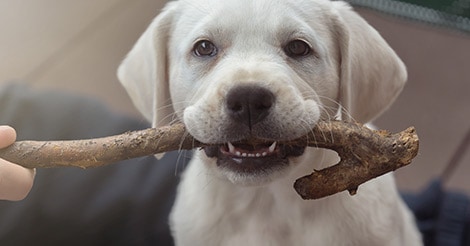Like people, our canine pets have two sets of teeth in their lives. Dogs have 28 deciduous teeth (also known as baby or puppy teeth) and 42 permanent (adult) teeth.
Puppies are born without any visible teeth. Their deciduous teeth start erupting through the gums around three weeks of age and normally finish erupting by four months of age.
Adult teeth begin erupting when puppies are about 3.5 to 4 months of age and normally are in place by 6 months of age. As the adult teeth develop and get bigger, they press against the roots of the baby teeth. The baby tooth roots weaken and finally disappear, leaving only the crowns behind. As the adult teeth push through the gums, the crowns of the baby teeth fall out to allow room for the permanent teeth.
Sometimes, the baby teeth don’t fall out properly, leaving your dog with “retained deciduous teeth” (retained deciduous teeth are rare in cats, but not uncommon in dogs, especially small breed dogs).
Here’s an overview of the process and how your veterinarian will treat your pet is some of its baby teeth are retained.
What is a retained tooth?
A retained tooth is a deciduous (baby) tooth that is still present in the mouth after its replacement permanent adult tooth has also grown in.
When this happens, the baby tooth occupies the place in the mouth that is meant for the permanent tooth. The end result is often crowding or malpositioning of the teeth, causing abnormal bite.
Which teeth are most commonly retained?
The most common deciduous teeth to be retained in dogs are the upper canine teeth, followed by the lower canine teeth and the incisors. The premolar teeth may also be retained.
We often see retained teeth in small breed dogs such as Maltese, Yorkshire Terriers and Miniature Schnauzers, as well as in dogs with pushed-in faces, such as Bulldogs, Pugs, Boston Terriers and Boxers.
What problems do retained teeth cause?
If both a deciduous and a permanent took are in the same socket in the jaw, the crowding of the two teeth will increase the likelihood that:
- Food and debris will become trapped between the teeth
- Permanent teeth may move to abnormal positions.
- Stretching of the tooth attachment can lead to painful periodontal disease.
If the retained tooth is a lower canine, the permanent tooth may be forced to grow on the inside of the lower jaw, and its tip can dig into the roof of the mouth.
When and how are retained teeth treated?
No two teeth should be in the same socket at the same time. If you notice a retained tooth in your puppy or kittens mouth, make an immediate appointment for an examination. Unless the baby tooth is very mobile, extraction of the tooth and root is the treatment of choice. If it is very mobile, it will probably fall out in a day or two. If not, a trip to your veterinarian is in order. Early extraction will usually allow the adult tooth to move into its proper position. Often, we can perform these extractions at the same time that we spay or neuter your pet.
